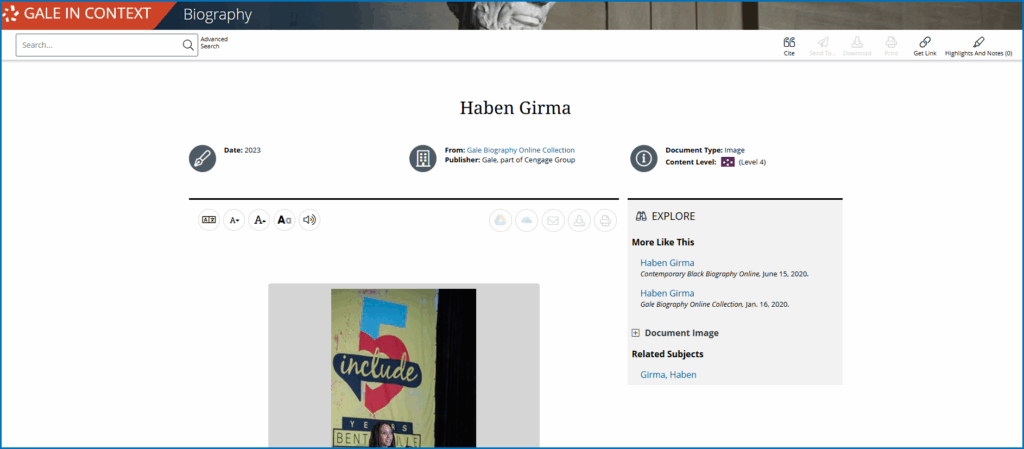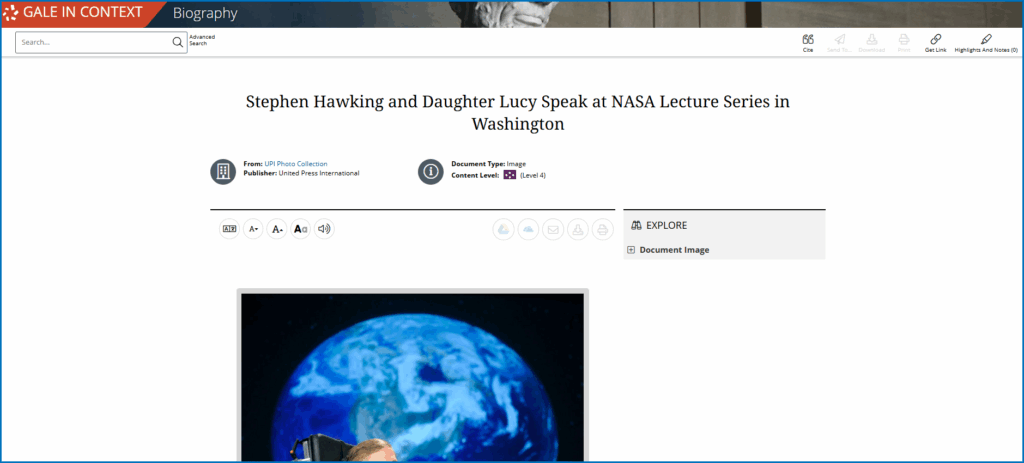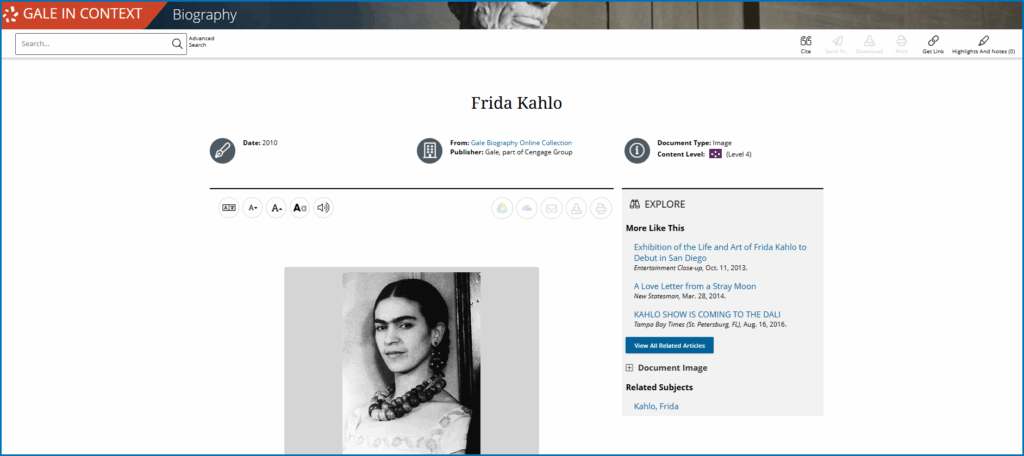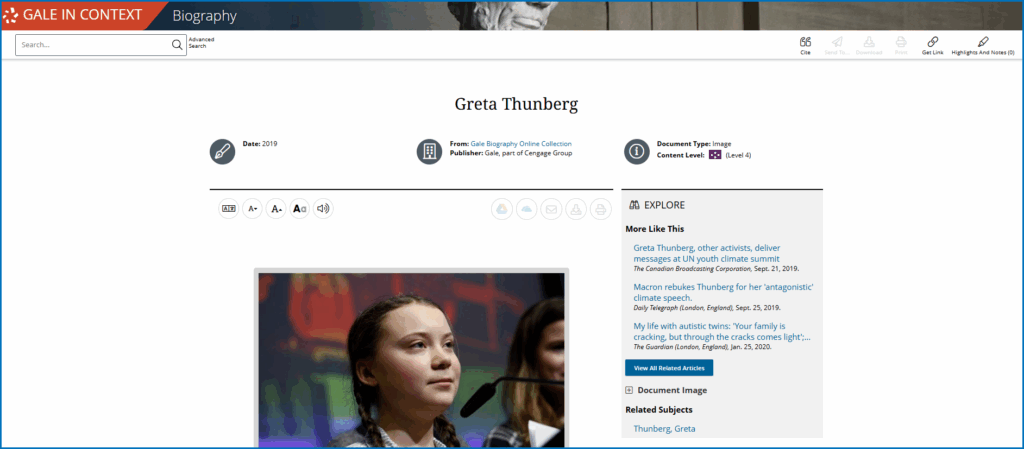Every culture organizes itself around what it assumes to be “normal,” and those assumptions decide who moves easily through the world and who has to fight to take part. When public spaces, institutions, and policies are built around a single standard of ability, they leave little room for the full range of human experience.
The United Nations introduced the International Day of Persons with Disabilities in 1992 to draw global attention to the ways exclusion limits progress. Each year on December 3, it encourages communities to identify barriers and redesign systems so that everyone can contribute on equal terms.
Gale In Context: Biography gives students a place to discover how people with disabilities have shaped science, art, politics, and culture throughout history. Each biographical topic page captures the depth of their contributions and the insight they brought to their work, reminding us how much societies gain when every individual has the chance to participate fully.
Because no single format can capture a life in full, Gale In Context: Biography brings together video interviews, audio recordings, primary documents, and full-text articles to show each figure from multiple perspectives.
Speaking Respectfully About Disabilities
When educators use humanizing, respectful language, they show that disability is part of human diversity, offering perspectives that challenge assumptions and expand what inclusion can look like.
That understanding begins with word choice. Some people prefer person-first phrasing, such as referring to a person with cerebral palsy, to emphasize individuality before the condition. Others use identity-first language, like deaf writer or autistic scientist, to express belonging and pride.
The key is to talk about the person as a person—to recognize their autonomy in how they define themselves and to use language that reflects their humanity rather than their condition.
Haben Girma (b. 1988)
Haben Girma is a lawyer, author, and leading advocate for accessible technology and disability rights. She made history as Harvard Law’s first Deafblind graduate, relying on a communication system she adapted—connecting a wireless keyboard to a refreshable Braille display—to keep up with lectures and conversation in real time.
In 2019, Lenovo named Girma as their first accessibility and inclusion advisor to help develop more inclusive product design. Previously, she also challenged the tech industry in court. While at the law firm Disability Rights Advocates, she helped argue National Federation of the Blind v. Scribd, Inc., a landmark case requiring digital platforms to comply with ADA standards.
Stephen Hawking (1942–2018)
While studying at the University of Cambridge, astrophysicist Stephen Hawking investigated what happens to matter and energy near a black hole. His calculations showed that black holes slowly emit energy as heat—an idea that became known as Hawking radiation. The discovery offered one of the first links between quantum mechanics and Einstein’s theory of relativity, changing how scientists understand the structure of the universe.
Hawking was diagnosed with ALS, or Lou Gehrig’s disease, in his early twenties and gradually lost the use of his limbs and speech. However, with the aid of computer-based communication tools, he enthusiastically continued his research and teaching for decades.
His book A Brief History of Time (1988) brought complex ideas about black holes and the origins of the universe to general readers, remaining on international bestseller lists for years and introducing cosmology to millions.
Hawking’s life and work invite deeper discussions about accessibility in science. Explore ways to frame that conversation with the human story behind ALS.
Judith Heumann (1947–2023)
After contracting polio as a toddler, Judith Heumann grew up using a wheelchair in New York City, where most schools and public buildings were still inaccessible. When she earned her teaching degree in the 1960s, the New York City Board of Education denied her a license, arguing she could not evacuate a classroom in an emergency. Heumann sued in Heumann v. Board of Education of the City of New York and won, becoming the city’s first wheelchair-using teacher and establishing a legal precedent against workplace discrimination.
She went on to pursue groundbreaking advocacy work, helping launch the Independent Living movement and co-founding the World Institute on Disability. As one of the organizers of the 1977 Section 504 sit-ins, Heumann was also instrumental in pushing the U.S. government to enforce civil rights protections for disabled Americans. She went on to have a career in politics as the assistant secretary of education for special education and rehabilitative services and special advisor on disability rights.
Explore approaches to creating more inclusive learning spaces in your school.
Frida Kahlo (1907–54)
Frida Kahlo lived with chronic pain for most of her life, first from childhood polio, later from severe spinal and pelvic injuries in a streetcar accident at 18. After the accident, Kahlo spent months in traction at home. Her mother bought her a special easel so she could paint while lying flat, and a mirror was suspended above her bed so she could see her reflection. The first works she made during that time were almost clinical studies of her face, but they grew more symbolic as her health worsened.
Over time, Kahlo became one of Mexico’s most recognizable painters, known for self-portraits that examined her own identity as a woman, an artist, and a Mexican living through a time of dramatic political change. One of her best-known works, The Two Fridas (1939), shows two versions of herself—one in traditional Tehuana dress and one in European clothing—connected by a single vein between their hearts. The image mirrored Mexico’s own struggle to define itself in the years after the revolution and became a lasting symbol of personal and national identity.
Marlee Matlin (b. 1965)
Marlee Matlin’s breakout performance in Children of a Lesser God (1986) earned her an Academy Award for Best Actress, making her the first Deaf actor to win an Oscar. In the decades since, she’s become a consistent presence on screen, from The West Wing to Switched at Birth and the Oscar-winning film CODA.
Offscreen, Matlin has been a leading voice for equal access in entertainment, advocating for captioning standards, sign-language interpreters at public events, and genuine representation of Deaf culture in media.
John Nash (1928–2015)
While studying game theory at Princeton, John Nash developed a way to predict how people or groups make decisions when their outcomes depend on one another. His model—the Nash equilibrium—helps explain situations like two countries deciding whether to disarm or continue an arms race, where each side’s best choice depends on the other’s move. The concept revolutionized modern economics and has gone on to provide new tools for understanding competition across many different fields.
In his thirties, Nash was diagnosed with paranoid schizophrenia and withdrew from formal academic work. Though he no longer held a teaching position, he spent his day on Princeton’s campus, working through equations on blackboards in Fine Hall, attending seminars, and discussing mathematics with colleagues who recognized his brilliance even during his illness.
Gradually, with support from family and the academic community in Princeton’s math department, Nash was able to reignite his career. In 1994, he was honored with the Nobel Prize in Economic Sciences.

Hirotada Ototake (b. 1976)
Author and sports journalist Hirotada Ototake was born with a condition called tetra-amelia syndrome, which left him without arms or legs. After graduating from Waseda University, he gained national attention as a sports reporter covering basketball and Paralympic events, where his commentary emphasized traits like teamwork and perseverance.
His 1998 memoir, No One’s Perfect, became a national bestseller, praised for its humor and clear-eyed look at growing up in a society still learning what inclusion could mean. Ototake later became a teacher and accessibility advocate, working with schools to create environments that support diverse learners.
Greta Thunberg (b. 2003)
In 2018, fifteen-year-old Greta Thunberg began spending her Fridays outside the Swedish Parliament with a cardboard sign calling for climate accountability. She was frustrated by her country’s slow progress on the Paris Agreement—and by how easily adults seemed to accept government inaction on climate promises. Her small act of defiance drew unexpected attention, sparking student walkouts that grew into the global movement now called Fridays for Future.
Thunberg describes her autism as a strength that helps her stay rooted in data when political arguments drift from the science. That focus has seen her influence continue to grow. She has spoken before the United Nations, sailed across the Atlantic to attend the Climate Action Summit, and joined student protests in cities around the world.
The International Day of Persons with Disabilities reminds us of the benefits communities gain when everyone has the chance to participate fully. Still, the work of inclusion doesn’t end on December 3. For educators, that work continues in the classroom through the resources they select and how those materials reach every student.
Gale In Context: Biography combines trustworthy materials covering diverse life stories with accessibility tools that adapt to different learning styles. Features like text-to-speech, translation, and reading-level options ensure that all students can engage with the content, creating a classroom where inclusion is built into learning itself.
Reach out to your Gale sales representative for more information on how Gale In Context: Biography supports inclusive, accessible classrooms.








